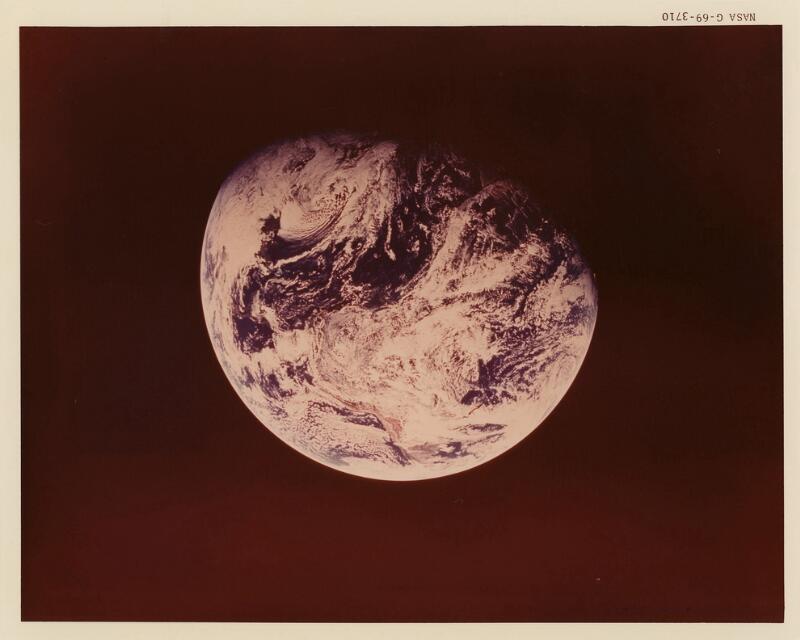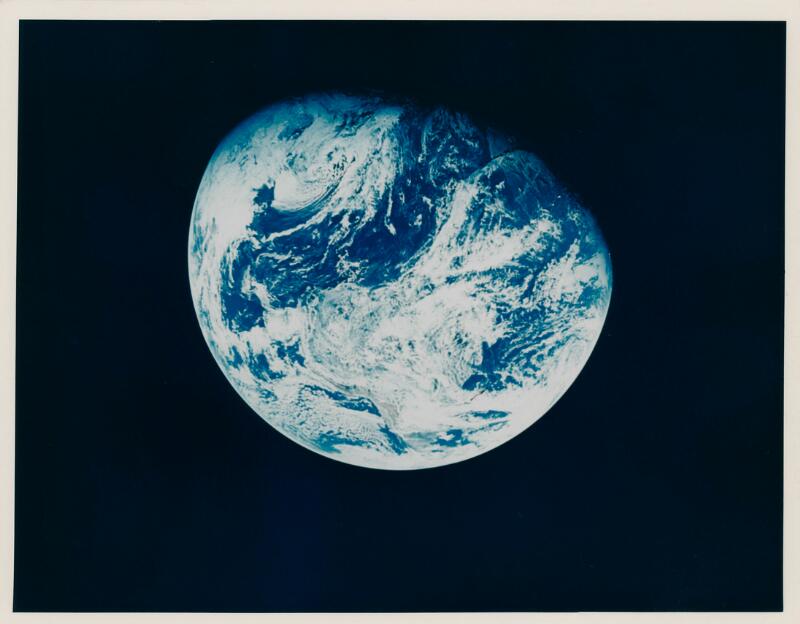"In other words we think we have found the basic copying mechanism by which life comes from life..."
"In other words we think we have found the basic copying mechanism by which life comes from life..." "Twice, especially, since 1900, scientists and their ideas have generated a transformation so broad and so deep that it touches everyone's most intimate sense of the nature of things. The first of these transformations was in physics, the second in biology. Between the two, we are most of us spontaneously more interested in the science of life..." (Horace Freeland Judson, The Eighth Day of Creation ). CRICK, Francis Harry Compton (1916-2004). Autograph Letter Signed ("Daddy") to his son Michael, outlining the revolutionary discovery of the structure and function of DNA. Cambridge, 19 March 1953. 7 pages, 4to, on Basildon bond blue writing paper, watermarked ...written on rectos and versos (each sheet with two small hole-punches, otherwise very fine). MORE THAN ONE MONTH BEFORE THE FIRST PUBLISHED ANNOUNCEMENT, FRANCIS CRICK, THE CO-DISCOVERER OF THE STRUCTURE AND FUNCTION OF DNA, DETAILS ONE OF THE MOST IMPORTANT SCIENTIFIC DISCOVERIES OF THE 20TH CENTURY--THE 'SECRET OF LIFE'--TO HIS SON "We have discovered the secret of life," Francis Crick announced to the patrons of the Eagle Pub in Cambridge on that historic afternoon of February 1953. According to his co-discoverer James D. Watson: "As was normal for a Saturday morning, I got to work at Cambridge University's Cavendish Laboratory earlier than Francis Crick on February 28, 1953. I had good reason for being up early. I knew that we were close--though I had no idea just how close--to figuring out the structure of a then little-known molecule called deoxyribonucleic acid: DNA. This was not any old molecule: DNA, as Crick and I appreciated, holds the very key to the nature of living things. It stores the hereditary information that is passed on from one generation to the next, and it orchestrates the incredibly complex world of the cell. Figuring out its three-dimensional structure--the architecture by which the molecule is put together--would, we hoped, provide a glimpse of what Crick referred to only half-jokingly as 'the secret of life'" (James Watson DNA: The Secret of Life , NY, 2003, preface). Francis Crick was born in Northampton, England in 1916, to a family which ran a successful shoemaking firm. Crick's grandfather was a shoemaker and an amateur scientist; his father's brother Walter was also science-minded, and he and Francis conducted chemical experiments together when he was young. Crick studied physics at University College in London, but his studies were interrupted by service in World War II. During the war he worked as a scientist for the British Admiralty, where he contributed important work in connection with magnetic and acoustic mines. After the War, Crick left the Admiralty in 1947 to study biological research at the Strangeways Laboratory in Cambridge. Although the research did not excite him, from there he was able to keep up on developments in the fields of genetics and bacteriology, and in 1949, he transferred to the Cavendish Laboratory, headed by Nobel Laureate Sir Lawrence Bragg. There he would join the new unit established by the Medical Research Council (MRC) to study protein structure using X-rays working alongside future Nobel laureates Max Perutz and John Kendrew. Crick was 33 years old and still a graduate student when the young American, James D. Watson arrived at the Cavendish. Twelve years Crick's junior, Watson had already completed his Ph.D in 1950, and was determined to pursue the nature of the gene and its chemical basis. He and Crick were assigned an office together and quickly began to share their ideas on the physical nature of the gene and how to determine the structure of DNA. Unlike the experimentalists Maurice Wilkins and Rosalind Franklin, they believed the structure could be determined through a combination of data and theory, and model-building to see which structures made the most sense. Watson's carefully construc
"In other words we think we have found the basic copying mechanism by which life comes from life..."
"In other words we think we have found the basic copying mechanism by which life comes from life..." "Twice, especially, since 1900, scientists and their ideas have generated a transformation so broad and so deep that it touches everyone's most intimate sense of the nature of things. The first of these transformations was in physics, the second in biology. Between the two, we are most of us spontaneously more interested in the science of life..." (Horace Freeland Judson, The Eighth Day of Creation ). CRICK, Francis Harry Compton (1916-2004). Autograph Letter Signed ("Daddy") to his son Michael, outlining the revolutionary discovery of the structure and function of DNA. Cambridge, 19 March 1953. 7 pages, 4to, on Basildon bond blue writing paper, watermarked ...written on rectos and versos (each sheet with two small hole-punches, otherwise very fine). MORE THAN ONE MONTH BEFORE THE FIRST PUBLISHED ANNOUNCEMENT, FRANCIS CRICK, THE CO-DISCOVERER OF THE STRUCTURE AND FUNCTION OF DNA, DETAILS ONE OF THE MOST IMPORTANT SCIENTIFIC DISCOVERIES OF THE 20TH CENTURY--THE 'SECRET OF LIFE'--TO HIS SON "We have discovered the secret of life," Francis Crick announced to the patrons of the Eagle Pub in Cambridge on that historic afternoon of February 1953. According to his co-discoverer James D. Watson: "As was normal for a Saturday morning, I got to work at Cambridge University's Cavendish Laboratory earlier than Francis Crick on February 28, 1953. I had good reason for being up early. I knew that we were close--though I had no idea just how close--to figuring out the structure of a then little-known molecule called deoxyribonucleic acid: DNA. This was not any old molecule: DNA, as Crick and I appreciated, holds the very key to the nature of living things. It stores the hereditary information that is passed on from one generation to the next, and it orchestrates the incredibly complex world of the cell. Figuring out its three-dimensional structure--the architecture by which the molecule is put together--would, we hoped, provide a glimpse of what Crick referred to only half-jokingly as 'the secret of life'" (James Watson DNA: The Secret of Life , NY, 2003, preface). Francis Crick was born in Northampton, England in 1916, to a family which ran a successful shoemaking firm. Crick's grandfather was a shoemaker and an amateur scientist; his father's brother Walter was also science-minded, and he and Francis conducted chemical experiments together when he was young. Crick studied physics at University College in London, but his studies were interrupted by service in World War II. During the war he worked as a scientist for the British Admiralty, where he contributed important work in connection with magnetic and acoustic mines. After the War, Crick left the Admiralty in 1947 to study biological research at the Strangeways Laboratory in Cambridge. Although the research did not excite him, from there he was able to keep up on developments in the fields of genetics and bacteriology, and in 1949, he transferred to the Cavendish Laboratory, headed by Nobel Laureate Sir Lawrence Bragg. There he would join the new unit established by the Medical Research Council (MRC) to study protein structure using X-rays working alongside future Nobel laureates Max Perutz and John Kendrew. Crick was 33 years old and still a graduate student when the young American, James D. Watson arrived at the Cavendish. Twelve years Crick's junior, Watson had already completed his Ph.D in 1950, and was determined to pursue the nature of the gene and its chemical basis. He and Crick were assigned an office together and quickly began to share their ideas on the physical nature of the gene and how to determine the structure of DNA. Unlike the experimentalists Maurice Wilkins and Rosalind Franklin, they believed the structure could be determined through a combination of data and theory, and model-building to see which structures made the most sense. Watson's carefully construc










.jpg)




Testen Sie LotSearch und seine Premium-Features 7 Tage - ohne Kosten!
Lassen Sie sich automatisch über neue Objekte in kommenden Auktionen benachrichtigen.
Suchauftrag anlegen